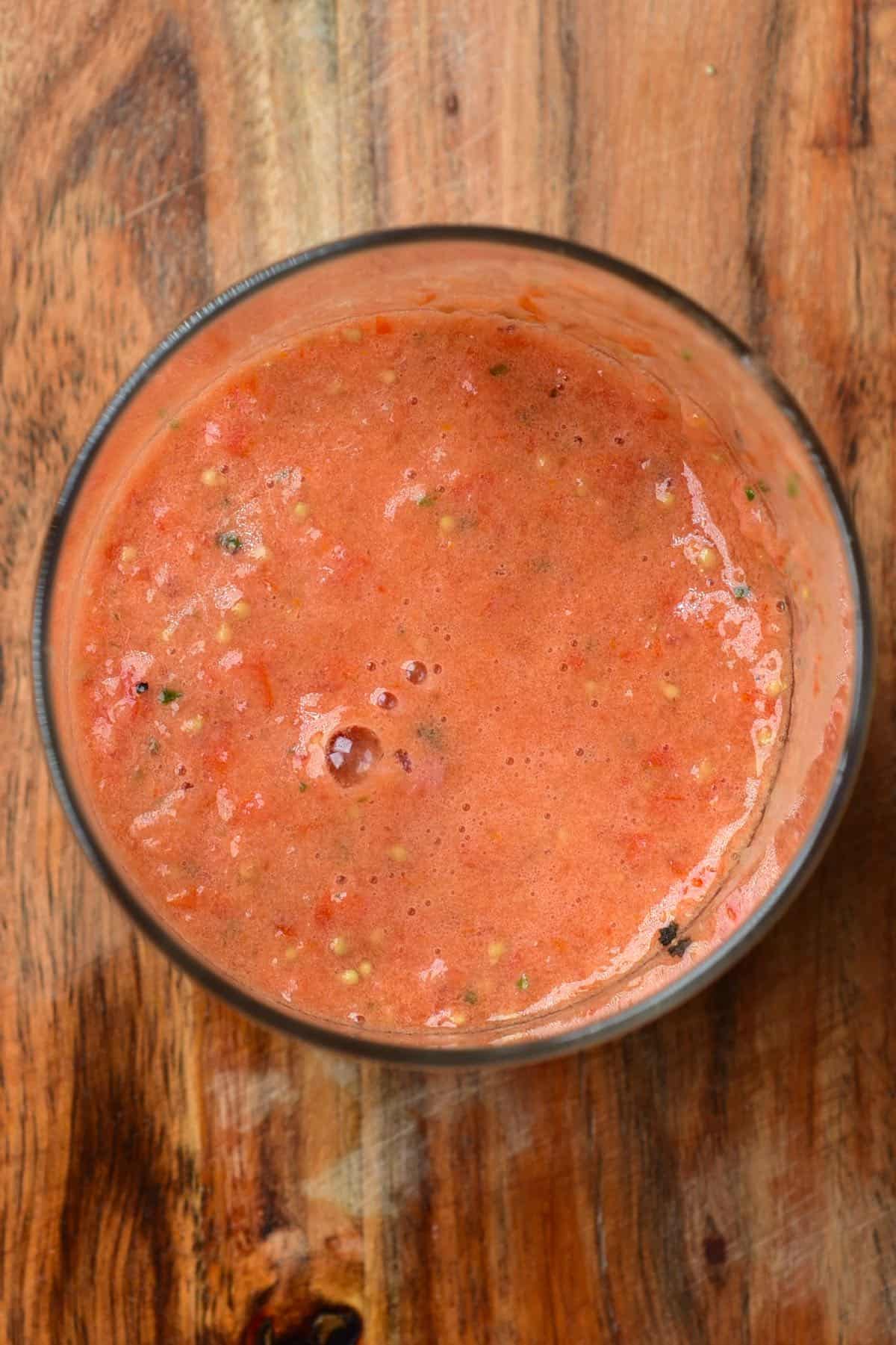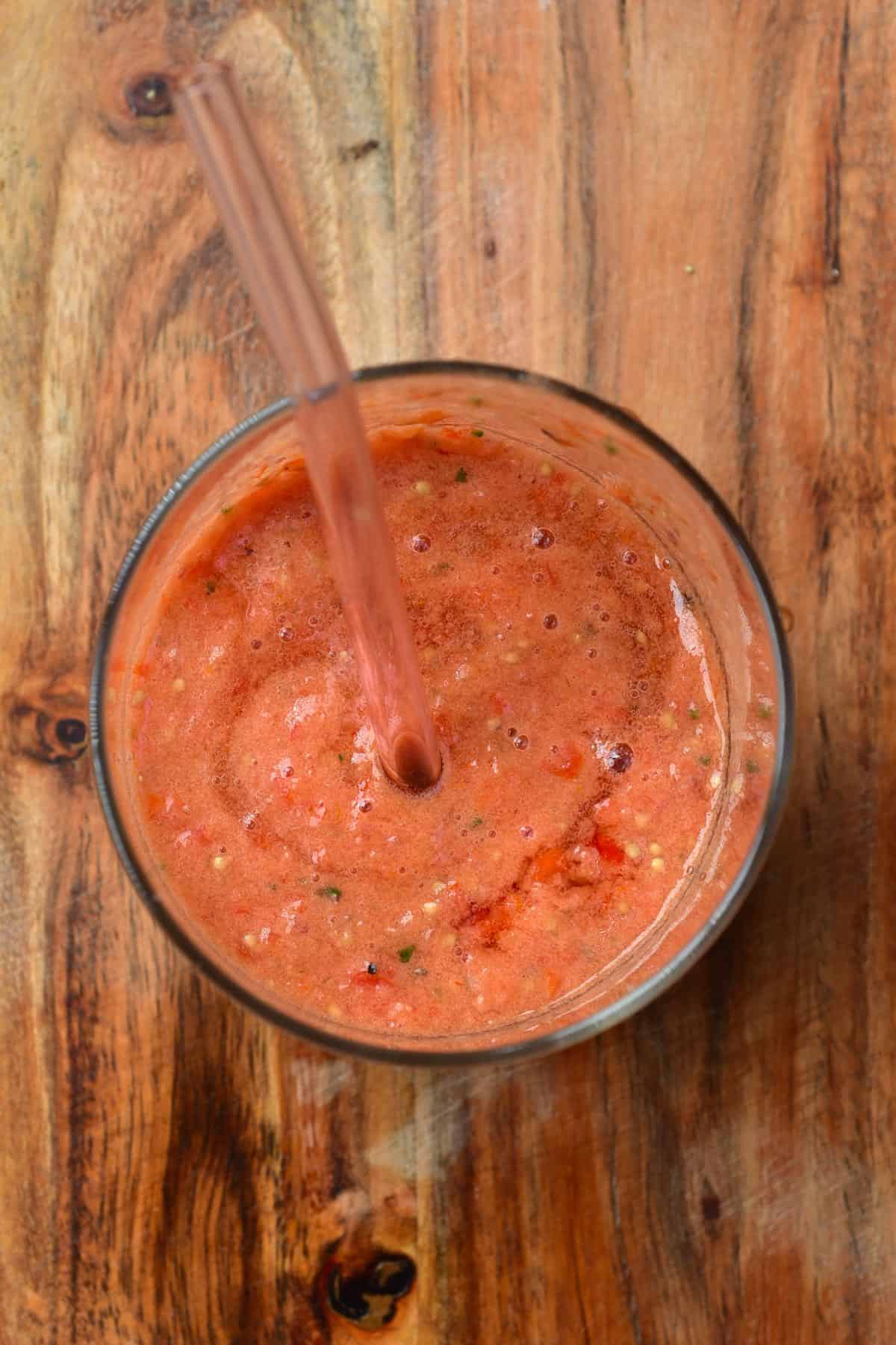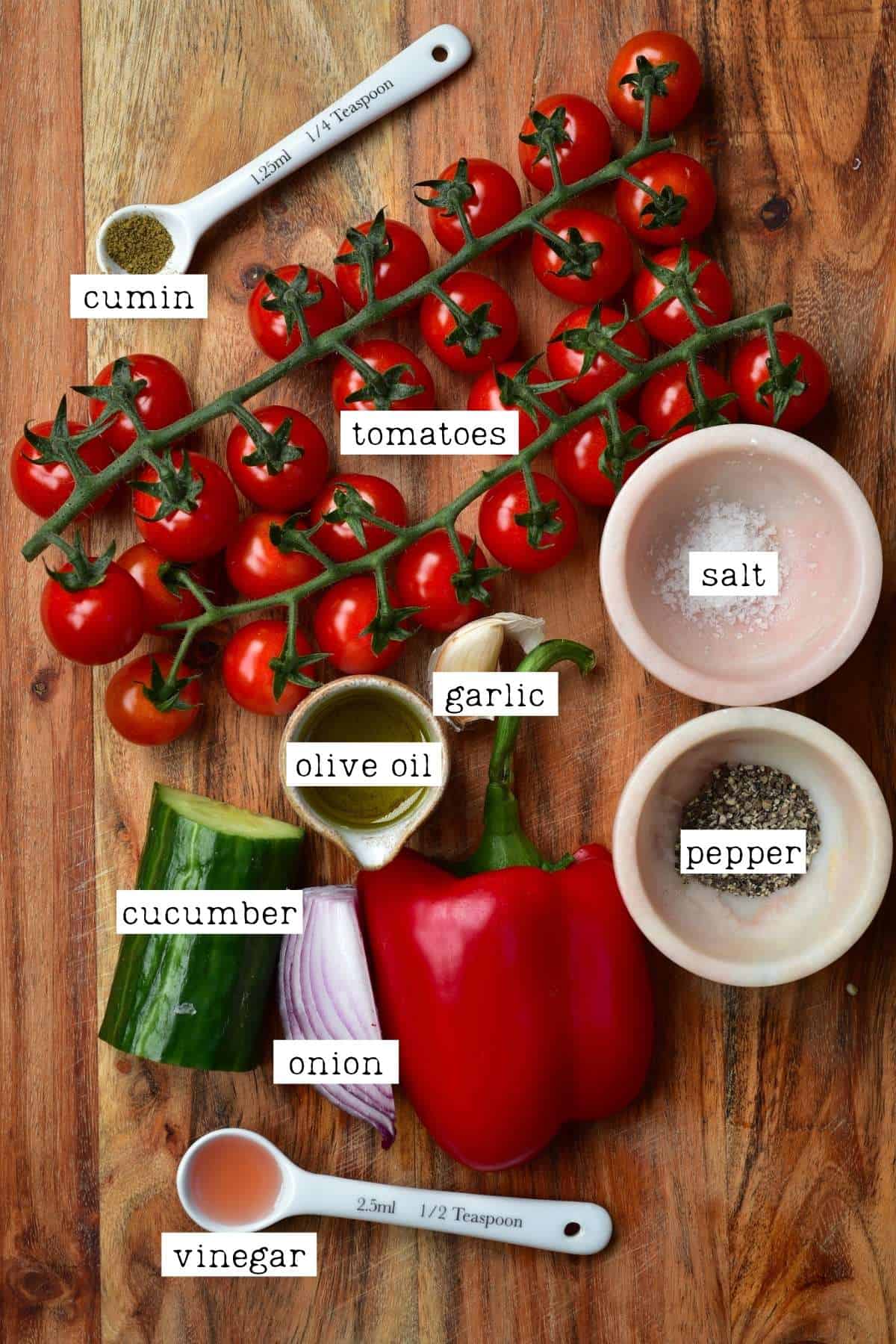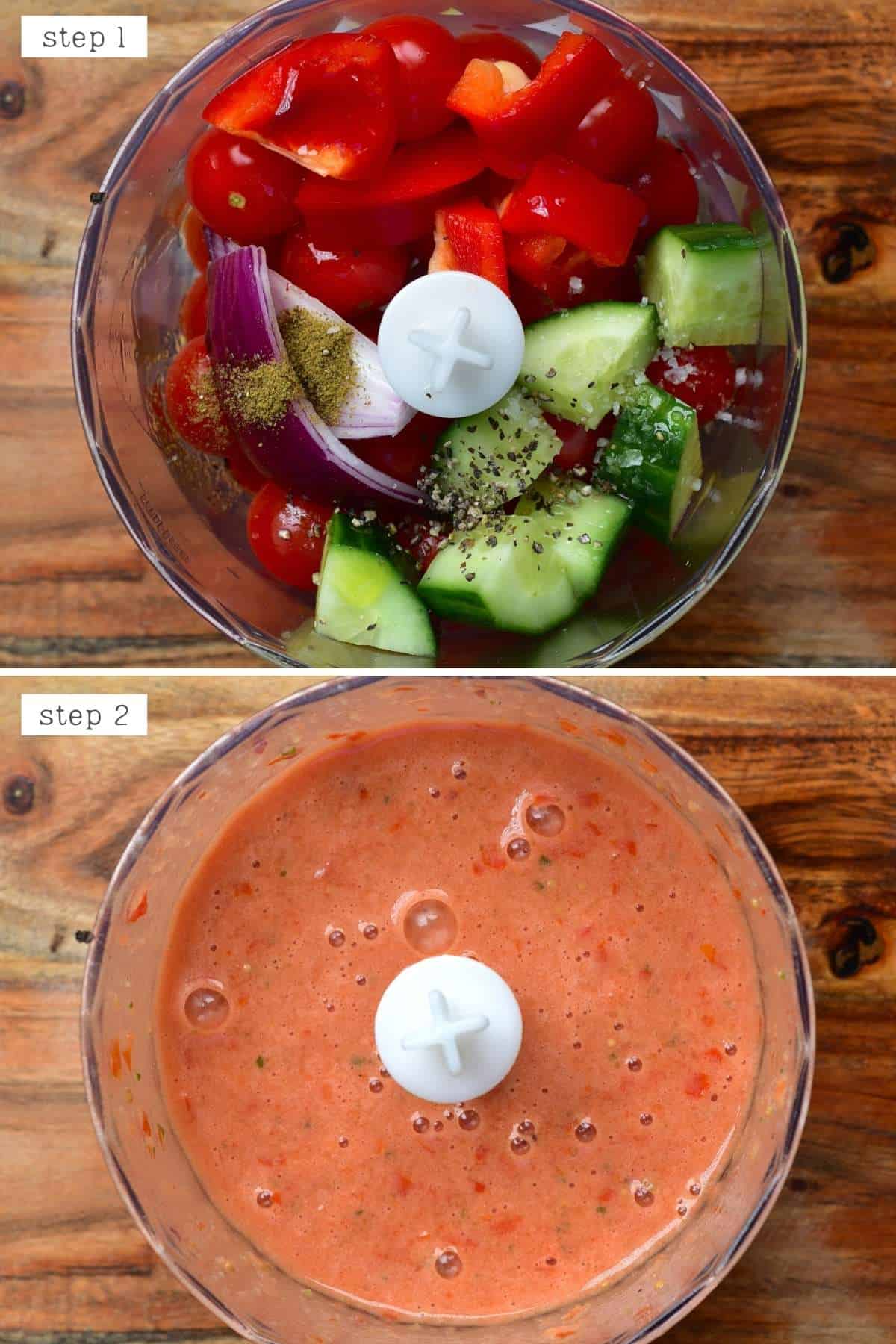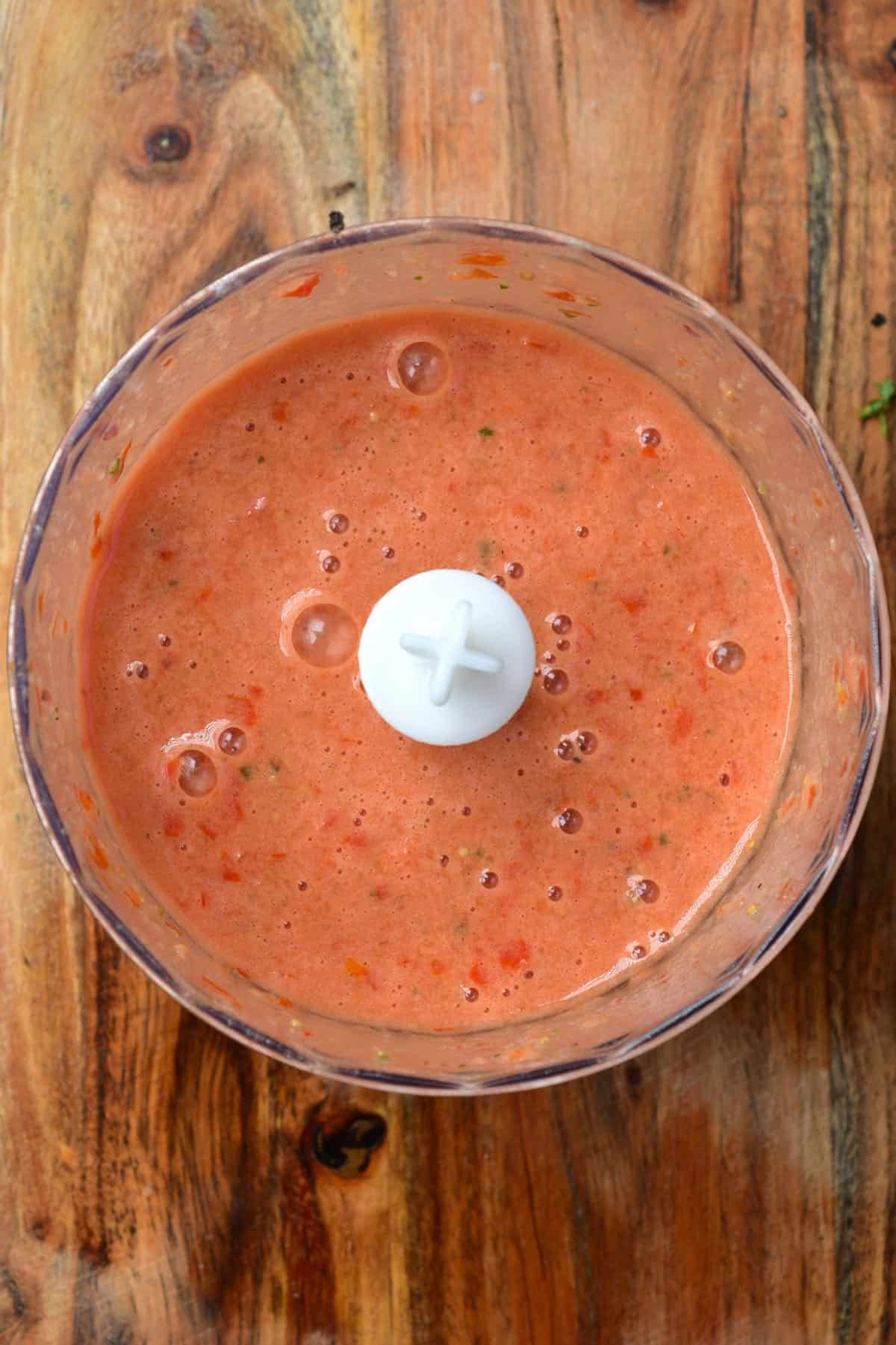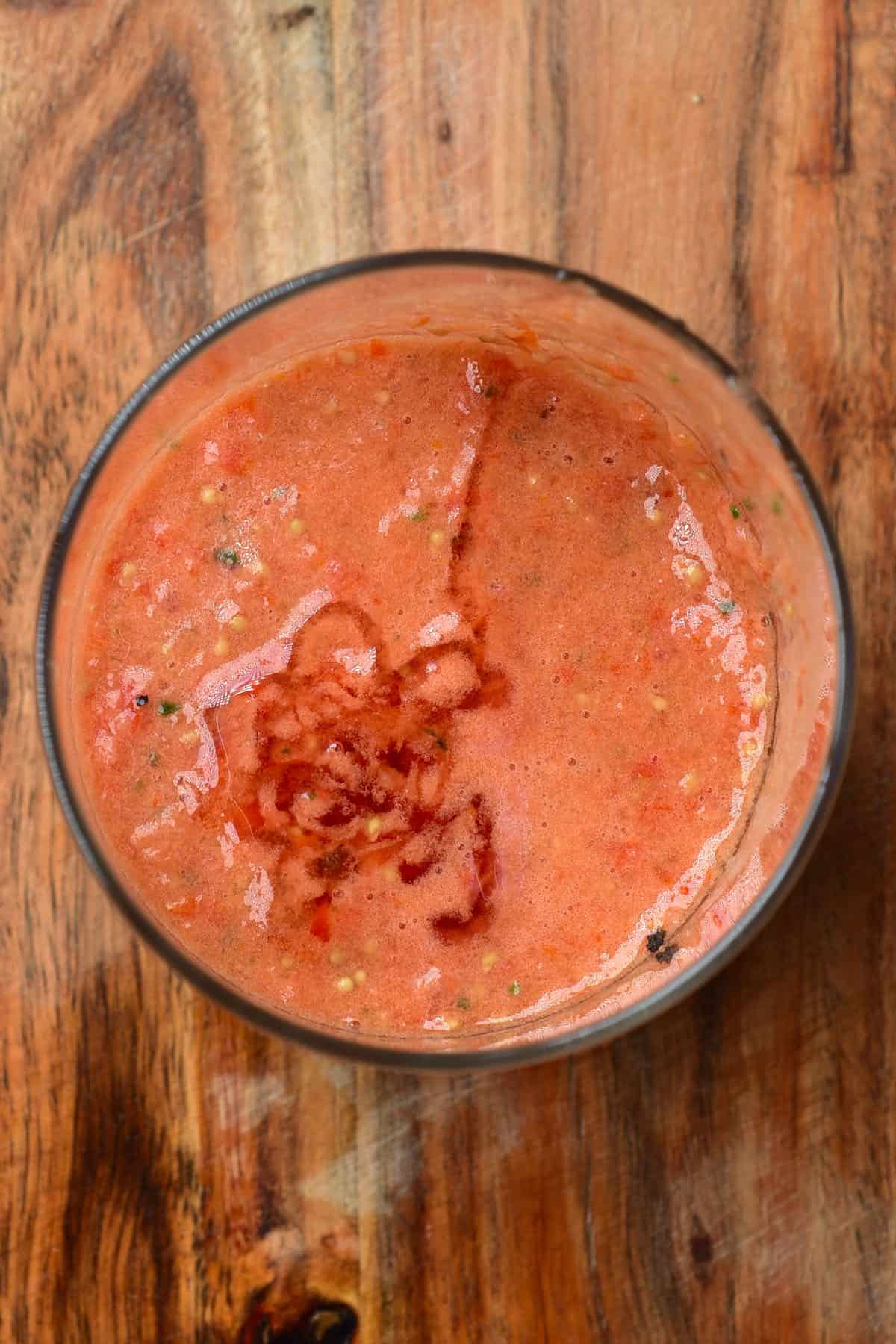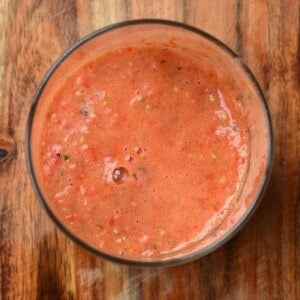It’s official, this year I’ve made it a mission of mine to appreciate tomatoes in every single way that I can. I’ve already recently shared recipes/DIYs for Tomato Confit (Slow-Roasted Tomatoes) and Easy Homemade Creamy Tomato Soup. Now it’s time to cool things down with this easy gazpacho soup (cold tomato soup). It was actually this simple Pico De Gallo (Salsa Fresca) recipe that I posted recently that first inspired this recipe. There’s something so special about how using just a few ripe and fresh ingredients can make something so delicious. Whether you’re someone who loves gazpacho soup, has never tried it, or thinks the idea of ‘cold soup’ is disgusting – the truth is, gazpacho just works!. The combination of flavors makes perfect sense when enjoying it cold; you won’t even question it! Just try this easy gazpacho recipe to see for yourself. When it comes to ingredients and texture, gazpacho recipes can wildly differ. However, this recipe requires just 8 ingredients and can be made super smooth or slightly chunky! Within this post, I’ll also provide several ways to prepare this Spanish gazpacho, with plenty of tips for the best homemade gazpacho soup you can make!
What is gazpacho?
Gazpacho is light and ultra-fresh cold soup made with raw, chopped fresh garden ingredients like tomato, peppers, onion, cucumber, vinegar (sherry vinegar is more authentic to Andalusia, where gazpacho originated), though it is often described as a ‘cold tomato soup.’ However, don’t be tempted to just grab a tin of tomato soup and eat it cold – it won’t be the same at all (seriously!). In fact, it’s all the preparation and quality of the ingredients that make it extraordinary. While this cold Spanish soup was originally a kind of “peasant food” made of simple, cheap, local produce (possibly originating with just stale bread, water, and olive oil! then later on vegetables were added too), there are several modern variations now including ingredients like strawberries, grapes, watermelon, seafood, and more. The origin of gazpacho can be traced to Andalusia and the Algarve regions in the south of Spain. It is also very popular in Portugal. The no-cook soup is a refreshing dish, enjoyed during the hot summers of the region it originates. However, it can be appreciated at any time of the year. Traditionally, Spanish gazpacho was prepared with a mortar and pestle, grinding the ingredients into a paste. Though these days, you can turn to a blender or food processor to do the same job. However, the ingredients and texture vary a lot!
The gazpacho ingredients
This easy gazpacho recipe requires just 8 ingredients, 10 if you count the salt & pepper!
Tomatoes: This is a crucial base ingredient to this cold tomato soup, so they need to be super ripe and juicy. You can use vine tomatoes (Roma), heirloom tomatoes, or even cherry tomatoes.
If you’re using a high-speed blender/food processor, you don’t need to peel the tomatoes. However, you may want to scoop out the flesh and seeds if you’re using larger tomatoes.
Onion: sweet yellow onion will work best. While it may have a strong flavor straight from the food processor, the flavor will mellow as it chills. Garlic: remove the green ‘germ’ from the center of the clove to remove bitterness. Otherwise, it will mellow as it melds with the other flavors of the gazpacho soup. Cucumber: Persian cucumbers work very well, peeled and seeded. However, I used English cucumber. Red pepper: feel free to substitute this for an orange or yellow pepper. Some people use green bell pepper instead. However, I find them a little bitter. Olive oil: use extra virgin olive oil for the best flavor. Herbs/Spices: I use a combination of cumin and salt & pepper. Cumin might seem odd, but this is actually a tip I picked up from a Spanish friend! You can experiment with the herbs/spices. Basil, smoked paprika, marjoram, and chili powder could all be used with this easy gazpacho. Vinegar: Sherry vinegar is the traditional option. However, you could substitute red wine vinegar. You could use balsamic vinegar and/or even a splash of hot sauce (or chili sauce) for a different flavor.
Top Tip: Depending on what tomatoes you use, you might want to add a pinch of sugar to the gazpacho soup.
How to make gazpacho
The “instant” version
If you have a high-speed blender, then you can make this ‘instant’ gazpacho in just minutes – no need to peel the tomatoes or cucumber! For this version, simply roughly chop all of the vegetables, add all of the ingredients into your blender, and blend it to the required consistency; chunky, slightly chunky, or smooth. For a nice variation, blend half of the ingredients until super smooth, and then add the remaining ingredients and pulse/blend until you reach your desired consistency. Taste the gazpacho and adjust the seasonings if necessary.
The “slower” version
This gazpacho recipe is still super simple but just takes a little more time to execute.
First, prepare the vegetables: Finely dice all the vegetables, making sure to remove the cucumber peel if you want smoother results. Prepare the tomatoes: For this method, we’ll be peeling the tomatoes. To make the tomatoes easy to peel, mark a small X on the bottom of the tomatoes and flash boil them in boiling water for 30 seconds. Then, immediately remove them from the boiling water (with a slotted spoon) and add them to ice water. At that point, the skins practically just slip off! Then, dice the tomato, removing the seeds if necessary.
Chef’s Tip: If you DO have a high-speed blender that will blend the tomatoes enough not to leave you with chewy bits of papery skin in the soup, you can still omit this step.
Blend the gazpacho: Depending on the texture of the gazpacho that you’d like, you can blend the ingredients in one go into a chunky or smooth consistency. Alternatively, blend just half of the vegetables first into a smooth soup consistency, add in the remainder of the ingredients and continue to pulse to your desired consistency.
For better consistency, I recommend slowly adding in the olive oil while the ingredients blend. This will help it blend more evenly into the cold tomato soup and provide a better texture.
After blending
No matter which method you used, it’s time to chill the gazpacho soup. That’s KEY to the best flavor, as the flavors will meld and marinate. This is particularly important with the raw flavors of onion and garlic. I suggest making this gazpacho at least 3-4 hours in advance and chilling until you’re ready to serve. The olive oil can solidify slightly when chilled. For that reason, you may need to remove it from the refrigerator a little while before serving.
What to serve with gazpacho
How To Serve
You can serve gazpacho soup in a bowl, mug, or even shot glasses (for appetizer portions). Alternatively, serve in a large glass over ice with a straw!
To Garnish
Depending on how you plan to serve the gazpacho soup, there are several ways to garnish the cold Spanish soup – not least, with a little bit of finely diced vegetables. Other options include:
Extra diced vegetable: just save a few spoonfuls of the vegetables to one side to top the tomato gazpacho with. Fresh Herbs: green onions, dill, parsley, basil, chives, mint, etc., would all work. Olive Oil: you can’t go wrong with an extra drizzle of olive oil. Cream: just a drizzle of cream can be added – it will look and taste incredible! You could also use creme fraiche or sour cream instead. Croutons: as an homage to the addition of bread to traditional gazpacho, I often serve this soup with croutons. Cheese: a little crumbled feta or goat’s cheese pairs wonderfully with the fresh flavors. Boiled eggs: a sliced boiled egg is a traditional topping you could enjoy. Nuts & Seeds: a sprinkle of lightly toasted nuts or this omega sprinkle will add extra healthy fats and a little crunch. Serve alongside other tapas dishes like Healthy Patatas Bravas (Spanish Baked/Air Fryer Potatoes with Salsa Brava) and Fried Padrón Peppers (Blistered Mini Peppers).
How to store
Fridge: Store the gazpacho in an airtight container in the fridge for up to 5 days. It’s best to use a glass container (like a jar), as the tomatoes can stain plastic. If you’ve left it super chunky, then certain veg will go soggy after 1-2 days. Can you freeze gazpacho? Yes, I like to freeze it in single-serving portions, so I can thaw as much as needed at any one time. To do this, either keep it in freezer-safe bags or freezer-safe jars/containers. Leave a little space in the container for expansion. Freeze for up to 6 months! Thaw the soup in the fridge overnight before enjoying it! If the gazpacho was chunky, you might have textural differences – in which case, just pop it in a blender for a few seconds (You can always add some fresh chopped veggies if preferred).
Can you eat gazpacho warm?
While it’s originally meant as a cold tomato soup to be served chilled, there’s no reason that you can’t enjoy it warm. Simply warm it up on the stovetop or in the microwave until warm.
Do you need to make gazpacho ahead?
Yes, for best results, make the gazpacho soup at least 3-4 hours in advance. Because all of the ingredients or raw, they need the time to meld and marinate and come together. In fact, gazpacho tastes even better the day after preparing it!
What to do with leftover gazpacho?
If, for whatever reason, you’re looking for ideas on how to serve this gazpacho in alternative ways, then here are a few simple options.
As a salsa: Add some more chunky veg and serve as a salsa with Mexican rice and beans or even chips. Add to soups and stews: This will add flavor and work as a veggie stock in many ways. Use as a sauce: for pasta, proteins, etc.
Top tips
Gazpacho gets even better as it ages: As it rests in the fridge, the flavors will meld and become even better. If you can, I suggest waiting at least 3-4 hours before enjoying the gazpacho to give it time to marinate! Get creative with the garnish: This cold Spanish soup is very simple, which means you can get creative with the toppings/garnish to add extra flavor and texture. For a hearty gazpacho soup: I’ve left this gazpacho recipe bread-free. However, if you want to make a heartier meal, you could add some leftover grains like quinoa, farro, or even couscous. Make this gazpacho in-season for the best results: If you’re able to source delicious, ripe, juicy tomatoes out of season, wherever you live, then go for it. Otherwise, stick to in-season. I’d blame nearly 80% of ‘bland/boring/meh’ gazpacho solely on not using the very best ingredients. Be liberal with the seasonings: Cold soup actually requires more seasoning than hot soup. Season it, taste it, and then adjust as needed. You may even need to add a little extra seasoning after it’s rested in the fridge for a while. Olive oil may slightly solidify in the fridge, so you may wish to remove it from the fridge a little while before serving, to allow the oil to come to room temperature.
Related recipes
If you liked this easy gazpacho recipe, you may also enjoy these other simple soup and fresh salsa recipes!
Easy Homemade Creamy Tomato Soup Cream Of Mushroom Soup (GF, Vegan optional) Easy Vegan Potato Leek Soup (Chunky or Smooth) Roasted tomato soup Homemade Roasted Tomato Sauce (Homemade Pasta Sauce) How To Make Pico De Gallo (Salsa Fresca) Quick & Simple Watermelon Salsa Easy Mango Salsa (Mango Pico De Gallo) Summery Panzanella Salad (Tuscan-style Tomato and Bread Salad)
If you try this easy gazpacho recipe, then let me know your thoughts and questions in the comments. I’d also really appreciate a recipe rating and would love to see your recreations – just tag @AlphaFoodie.




